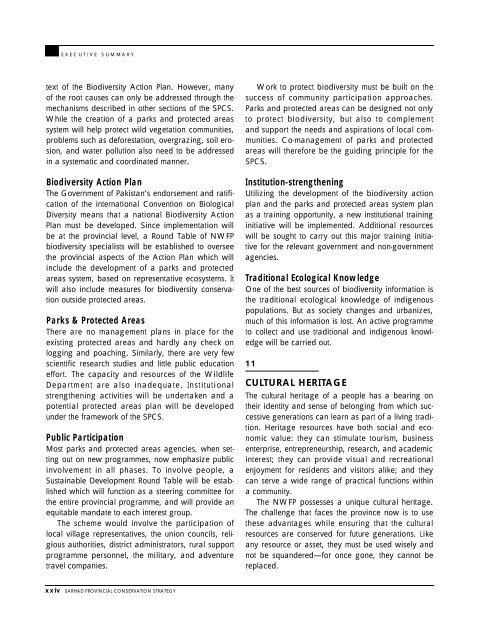Sarhad Provincial Conservation Strategy - IUCN
Sarhad Provincial Conservation Strategy - IUCN
Sarhad Provincial Conservation Strategy - IUCN
You also want an ePaper? Increase the reach of your titles
YUMPU automatically turns print PDFs into web optimized ePapers that Google loves.
E X E C U T I V E S U M M A R Y<br />
text of the Biodiversity Action Plan. However, many<br />
of the root causes can only be addressed through the<br />
mechanisms described in other sections of the SPCS.<br />
While the creation of a parks and protected areas<br />
system will help protect wild vegetation communities,<br />
problems such as deforestation, overgrazing, soil erosion,<br />
and water pollution also need to be addressed<br />
in a systematic and coordinated manner.<br />
Biodiversity Action Plan<br />
The Government of Pakistan’s endorsement and ratification<br />
of the international Convention on Biological<br />
Diversity means that a national Biodiversity Action<br />
Plan must be developed. Since implementation will<br />
be at the provincial level, a Round Table of NWFP<br />
biodiversity specialists will be established to oversee<br />
the provincial aspects of the Action Plan which will<br />
include the development of a parks and protected<br />
areas system, based on representative ecosystems. It<br />
will also include measures for biodiversity conservation<br />
outside protected areas.<br />
Parks & Protected Areas<br />
There are no management plans in place for the<br />
existing protected areas and hardly any check on<br />
logging and poaching. Similarly, there are very few<br />
scientific research studies and little public education<br />
effort. The capacity and resources of the Wildlife<br />
Department are also inadequate. Institutional<br />
strengthening activities will be undertaken and a<br />
potential protected areas plan will be developed<br />
under the framework of the SPCS.<br />
Public Participation<br />
Most parks and protected areas agencies, when setting<br />
out on new programmes, now emphasize public<br />
involvement in all phases. To involve people, a<br />
Sustainable Development Round Table will be established<br />
which will function as a steering committee for<br />
the entire provincial programme, and will provide an<br />
equitable mandate to each interest group.<br />
The scheme would involve the participation of<br />
local village representatives, the union councils, religious<br />
authorities, district administrators, rural support<br />
programme personnel, the military, and adventure<br />
travel companies.<br />
xxiv SARHAD PROVINCIAL CONSERVATION STRATEGY<br />
Work to protect biodiversity must be built on the<br />
success of community participation approaches.<br />
Parks and protected areas can be designed not only<br />
to protect biodiversity, but also to complement<br />
and support the needs and aspirations of local communities.<br />
Co-management of parks and protected<br />
areas will therefore be the guiding principle for the<br />
S P C S .<br />
Institution-strengthening<br />
Utilizing the development of the biodiversity action<br />
plan and the parks and protected areas system plan<br />
as a training opportunity, a new institutional training<br />
initiative will be implemented. Additional resources<br />
will be sought to carry out this major training initiative<br />
for the relevant government and non-government<br />
agencies.<br />
Traditional Ecological Knowledge<br />
One of the best sources of biodiversity information is<br />
the traditional ecological knowledge of indigenous<br />
populations. But as society changes and urbanizes,<br />
much of this information is lost. An active programme<br />
to collect and use traditional and indigenous knowledge<br />
will be carried out.<br />
11<br />
CULTURAL HERITAGE<br />
The cultural heritage of a people has a bearing on<br />
their identity and sense of belonging from which successive<br />
generations can learn as part of a living tradition.<br />
Heritage resources have both social and economic<br />
value: they can stimulate tourism, business<br />
enterprise, entrepreneurship, research, and academic<br />
interest; they can provide visual and recreational<br />
enjoyment for residents and visitors alike; and they<br />
can serve a wide range of practical functions within<br />
a community.<br />
The NWFP possesses a unique cultural heritage.<br />
The challenge that faces the province now is to use<br />
these advantages while ensuring that the cultural<br />
resources are conserved for future generations. Like<br />
any resource or asset, they must be used wisely and<br />
not be squandered—for once gone, they cannot be<br />
replaced.

















